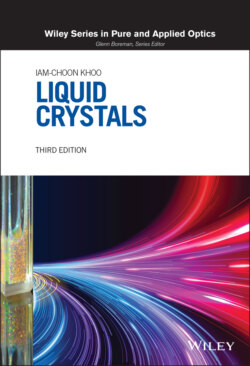Читать книгу Liquid Crystals - Iam-Choon Khoo - Страница 37
2.3.2. Nonequilibrium and Dynamical Dependence of the Order Parameter
ОглавлениеWhile the equilibrium statistical mechanics of the nematic liquid crystal order parameter and related physical properties near Tc are now well understood, the dynamical responses of the order parameter remain relatively unexplored. This is probably due to the fact that most studies of the order parameter near the phase transition point, such as the critical exponent, changes in molar volume, and other physical parameters, are directed at understanding the phase transition processes themselves and are usually performed with temperature changes occurring at very slow rates.
The temperature of the nematics can be abruptly raised by very short laser pulses [11, 12]. The pulse duration of the laser is in the nanosecond or picosecond time scale, which, as we shall see, is much shorter than the response time of the order parameter. As a result, the nematic film under study exhibits delayed signals.
Figure 2.3a and b shows the observed diffraction from a nematic film in a dynamic grating experiment [11]. As explained in more detail in Chapter 9, the diffracted signal is a measure of the dynamical change in the refractive index, Δn(t), following an instantaneous (delta function like) pump pulse. For a nematic liquid crystal, the principal change in the refractive index associated with a rise in temperature is through the density and order parameter [12]; that is,
Figure 2.3. (a) Observed oscilloscope trace of the diffracted signal in a dynamical scattering experiment involving microsecond infrared (CO2 at 10.6 μm) laser pump pulses. The sample used is a planar‐aligned nematic (E7) film; (b) observed oscilloscope trace of the diffracted signal from a nematic film under nanosecond visible (Nd:YAG at 0.53 μm) laser pump pulse excitation. The sample used is a planar‐aligned nematic (E7) film.
(2.21)
Unlike the change in order parameter, which is a collective molecular effect, the change in density dρ arises from the individual responses of the molecules and responds relatively quickly to the temperature change.
These results are reflected in Figure 2.3a and b. The diffracted signal contains an initial “spike,” which rises and decays away in the time scale on the order of the laser pulse. As shown in more detail in Chapter 9, this contribution comes from laser‐induced electrostriction or density changes that affect local order. On the other hand, the slowly rising contribution comes from laser‐induced temperature rise ΔT and the resulting order parameter change S(ΔT). The rate of change depends on the temporal characteristics of the incident laser. The buildup time is about 175 μs with microsecond infrared (10.6 μm) laser pulse (cf. Figure 2.3a) and 30 μs with nanosecond visible (0.53 μm) laser pulse (cf. Figure 2.3b).
Dynamical grating diffraction is thus a useful optical tool to probe the dynamics of the response of order parameter for molecules in various electronic/rovibrational energy states; in particular, the critical “slowing down” of the order parameter near Tc as shown in Figure 2.4 for the observed order parameter response times as the temperature approaches Tc obtained with infrared microseconds laser pulses.
Figure 2.4. Observed buildup times of the diffracted signal associated with order parameter change as a function of the temperature vicinity of Tc; excitation by infrared microsecond laser pulses on E7 nematic film.
Figure 2.5. Schematic depiction of the molecular levels involved in ground electronic state rovibrational excitations by infrared photo absorptions and excited electronic state excitation by visible photo absorptions.
One can also see from the relative heights of the density and order parameter components in Figure 2.3a and b that the overall response of the nematic film is different for the two forms of excitation. Absorption of infrared photons (λ = 10.6 μm) corresponds to the excitation of the ground (electronic) state’s rovibrational manifold, whereas the visible photo‐absorption (λ = 0.53 μm) corresponds to excitation of the molecules to the electronically excited states (cf. Figure 2.5). The electronic molecular structures of these two excited states are different and may therefore account for the different dynamical response behavior of the order parameter, which is dependent on the intermolecular Coulombic dipole–dipole interaction.
More on order parameter dynamics in the context of nonlinear optical responses and switching devices based on laser‐induced order parameter changes in liquid crystals are given in Chapters 9 and 12.
